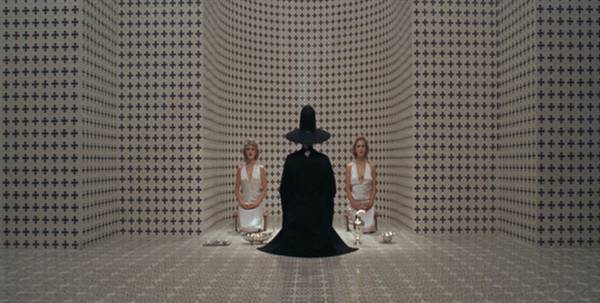THE HOLY MOUNTAIN (Alejandro Jodorowsky, 1973)
Rubin Museum of Art
150 West 17th St. at Seventh Ave.
Friday, October 29, free with $7 bar minimum, 9:30
212-620-5000
www.rmanyc.org
 For the third time in about a month, this rarely screened cult classic is being shown in the city, so you have no excuse to miss it yet again. Inspired by Rene Daumal’s MOUNT ANALOGUE: A NOVEL OF SYMBOLICALLY AUTHENTIC NON-EUCLIDEAN ADVENTURES IN MOUNTAIN CLIMBING, Alejandro Jodorowsky’s THE HOLY MOUNTAIN also involves symbolically non-Euclidean adventures in mountain climbing, funneled through Carlos Castaneda, Stanley Kubrick’s 2001: A SPACE ODYSSEY, and magic mushrooms and LSD galore. What passes for narrative follows a Jesus look-alike thief (Horacio Salinas) and an alchemist with a thing for female nudity (Jodorowsky) on the path to enlightenment; along the way they encounter the mysterious Tarot, stigmata, stoning, eyeballs, frogs, flies, cold-blooded murder, naked young boys, chakra points, life-size plaster casts, Nazi dancers, sex, violence, blood, gambling, turning human waste into gold, death and rebirth, and the search for the secret of immortality via representatives of the planets, each with their own extremely bizarre story to tell. Jodorowsky, who is credited with having invented the midnight movie with the acid Western EL TOPO (1970), literally shatters religious iconography in a kaleidoscopic whirlwind of jaw-droppingly gorgeous and often inexplicable imagery composed from a surreal color palette, set to a score by free jazz trumpeter Don Cherry and Archies keyboardist Ron Frangipane. (Frangipane also worked with John Lennon and Yoko Ono, who produced this film with their business manager, Allen Klein.) THE HOLY MOUNTAIN — which brings a whole new insight to Matthew Barney’s Cremaster Cycle — is filled with psychedelic mysticism centered around the human search for transcendence in a wilderness of the sacred and profane. Jodorowsky’s work can move you deeply, but don’t expect it to make much sense. Sit back and let in pour in and over you — you’ll feel it. You may hate it, but you’ll feel it. Although you’ll definitely hate the very end. This screening at the Rubin Museum of Art concludes the Icons series and will be introduced by multimedia poet Igor Satanovsky.
For the third time in about a month, this rarely screened cult classic is being shown in the city, so you have no excuse to miss it yet again. Inspired by Rene Daumal’s MOUNT ANALOGUE: A NOVEL OF SYMBOLICALLY AUTHENTIC NON-EUCLIDEAN ADVENTURES IN MOUNTAIN CLIMBING, Alejandro Jodorowsky’s THE HOLY MOUNTAIN also involves symbolically non-Euclidean adventures in mountain climbing, funneled through Carlos Castaneda, Stanley Kubrick’s 2001: A SPACE ODYSSEY, and magic mushrooms and LSD galore. What passes for narrative follows a Jesus look-alike thief (Horacio Salinas) and an alchemist with a thing for female nudity (Jodorowsky) on the path to enlightenment; along the way they encounter the mysterious Tarot, stigmata, stoning, eyeballs, frogs, flies, cold-blooded murder, naked young boys, chakra points, life-size plaster casts, Nazi dancers, sex, violence, blood, gambling, turning human waste into gold, death and rebirth, and the search for the secret of immortality via representatives of the planets, each with their own extremely bizarre story to tell. Jodorowsky, who is credited with having invented the midnight movie with the acid Western EL TOPO (1970), literally shatters religious iconography in a kaleidoscopic whirlwind of jaw-droppingly gorgeous and often inexplicable imagery composed from a surreal color palette, set to a score by free jazz trumpeter Don Cherry and Archies keyboardist Ron Frangipane. (Frangipane also worked with John Lennon and Yoko Ono, who produced this film with their business manager, Allen Klein.) THE HOLY MOUNTAIN — which brings a whole new insight to Matthew Barney’s Cremaster Cycle — is filled with psychedelic mysticism centered around the human search for transcendence in a wilderness of the sacred and profane. Jodorowsky’s work can move you deeply, but don’t expect it to make much sense. Sit back and let in pour in and over you — you’ll feel it. You may hate it, but you’ll feel it. Although you’ll definitely hate the very end. This screening at the Rubin Museum of Art concludes the Icons series and will be introduced by multimedia poet Igor Satanovsky.
